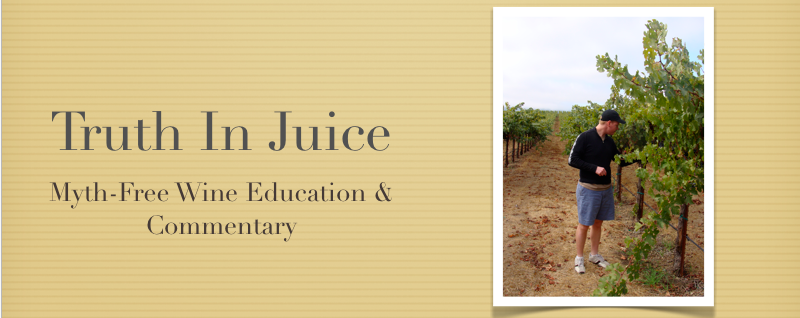The Judgment of Paris - A Tasting to Revisit
 Thursday, July 5, 2012 at 5:00PM
Thursday, July 5, 2012 at 5:00PM Recently, I was asked to lead a wine tasting for my girlfriend's book club. About a month earlier, at a spring barbeque, I had half-jokingly suggested that they read George Taber's The Judgment of Paris as their book for the month, saying that I would lead a wine tasting at the meeting if they did. While I'm not sure any of the club's members enjoyed the book as much as I did, Taber's account of the tasting is a must read for all wine lovers, and for historians interested in the history of the wine industry in California.
As the only journalist present at the 1976 tasting that pitted Napa Valley Chardonnay against Premier Cru and Grand Cru White Burgundies, and Napa Valley Cabernet against first and second growth Bordeaux, Taber was uniquely positioned to provide a retelling of this seminal event. However, a focal point of Taber's account of the tasting is the fact that the Tasting of Paris was a watershed moment that opened the door for the globalization of wine. In the early 1970's, California's wine industry was not well established, and the majority of wine consumers focused their attention on French wines, notably those from Burgundy and Bordeaux. In retrospect, the historical prominence of those two wine regions may have a lot to do with the current popularity of Cabernet Sauvignon, Pinot Noir, and Chardonnay.
A few years ago, in Boston, I was fortunate to have a customer bring in a wine catalogue from the early 1970's. It was striking to observe the limited availability of wines from countries outside of France, as well as the price differential between wines from Burgundy and Bordeaux and the rest of the world. First growth Bordeaux, as well as Premier Cru and Grand Cru Burgundy occupied nearly two-thirds of the catalogue, while regions such as California, Spain, Italy, France's Rhone Valley, and Alsace were confined to the back end of the catalogue. Other regions that are currently staples of many geographical oriented wine shops, such as Oregon, New Zealand and South America were left out entirely. Additionally, the first growth Bordeaux, and Premier Cru/Grand Cru Burgundies were priced between $4.00 and $8.00 per bottle in the catalogue, while virtually all other wines were priced below $2.00 per bottle. The wines from Spain were priced at $0.50 per bottle.
While my immediate reaction upon seeing that catalogue was to pine for the prices of yesteryear (imagine paying $8.00 for a bottle of Lafite Rothschild!), after thinking about it for a minute, I am much happier to be a wine consumer in this day and age. The amount of good wine that we have access to as consumers in today's marketplace is unprecedented. Wine making techniques have improved, and conscientious small production wine making is increasingly becoming more common. At the same time, importers and distributors are becoming ever more selective with their inventories, while broadening the geographic scope of their search for new wines. As a result, we are continually exposed to new grape varietals, and wines from countries that were not even on the radar of most oenophiles in the not too distant past. Grapes like Gruner Veltliner and Zweigelt from Austria are now some of the most sought after grapes in the US market, but most consumers were unaware of them as recently as 5 to 10 years ago. Argentinian Malbec, and Bordeaux-styled blends from Chile have also gained places of prominence with American consumers.
In the tasting I recently hosted, we conducted a blind tastings of Chardonnay, Pinot Noir, and a Bordeaux-styled or Meritage blend. There were 2-3 wines per flight, and all the wines came either from California, Burgundy, Bordeaux, or Chile. (A full list of the wines from our tasting can be found below.) Given that the group had read The Judgment of Paris, I wanted to recreate some of the flavor of the Paris Tasting, but at the same time illustrate that the wine world has changed a great deal since 1976. While both California and Oregon are known to produce world-renown Pinot Noir today, these wines were not thought fit to compete with the great Pinot Noirs of Burgundy at the time of the tasting. Similarly, Chile was but a blip on the radar of most wine consumers in 1976, but in 2012, the Chilean Pinot Noir and Cabernet Sauvignon fared competitively against their Californian and French counterparts.
There was not an overwhelming favorite among the group in any of the flights, which I think is fitting when one thinks about the globalization of wine. While it was a shock to see wines from California best highly pedigreed French wines back in 1976, in today's day and age, the wine community seems to be warming to the idea that good wine can come from anywhere. Barriers to wines from new regions, and from obscure grape varietals, are falling, and in my opinion, it has never been a better time to be a wine consumer. As we just celebrated Independence Day yesterday, it seems fitting to close by mentioning that The Tasting of Paris was conceived, in part, as a recognition of America's bicentennial celebration. There were considerable doubts about whether the American wines could compete with the French, but there was strong conviction from the American winemakers. Now 36 years later, the tasting is recognized as the watershed moment for the globalization of wine, and is credited with providing winemakers from all over the globe an opportunity to distribute their wines to a broader audience. While we may not have access to $8.00 per bottle Chateau Latour, it is a fantastic time to be a wine drinker. Cheers!
Wines From The Book Club Tasting
Chardonnay
- 2010 Chalone Vineyard Chardonnay, Monterey County, California
- 2010 Nicolas Potel Macon Villages, Burgundy, France
Pinot Noir
- 2010 Banshee Wines Rickshaw Pinot Noir, Sonoma, California
- 2008 Le Comte De Parm Hautes Cotes du Beaune, Burgundy, France
- 2010 Chilensis Pinot Noir, Riserva, Maule Valley, Chile
Cabernet Sauvignon/Bordeaux/Meritage Blends
- 2009 Errazuriz Cabernet Sauvignon Estate Reserve, Chile
- 2007 Kunde Estate Cabernet Sauvignon, Sonoma, California
- 2009 Chateau de Bel, Bordeaux, France



Reader Comments